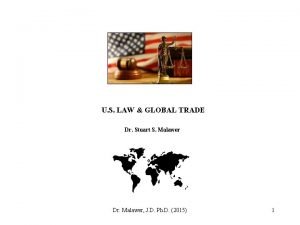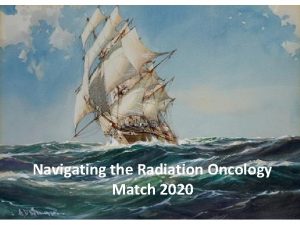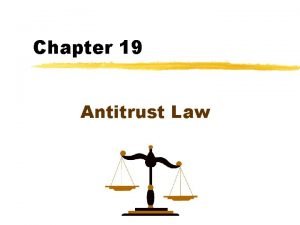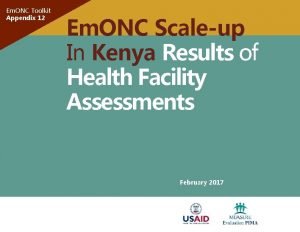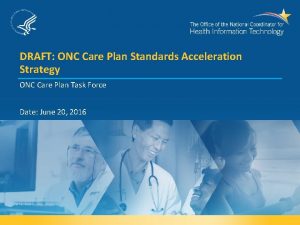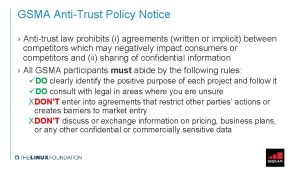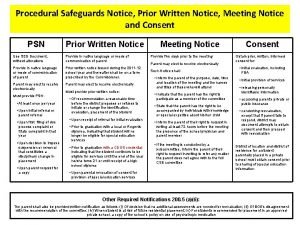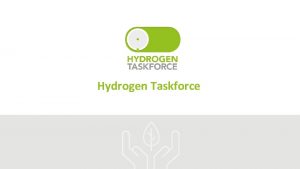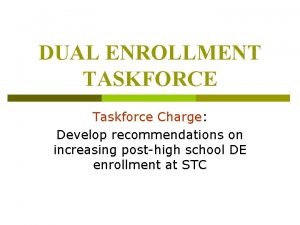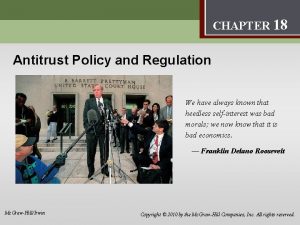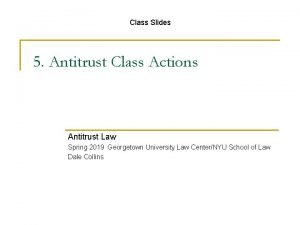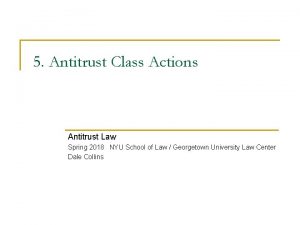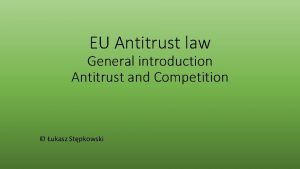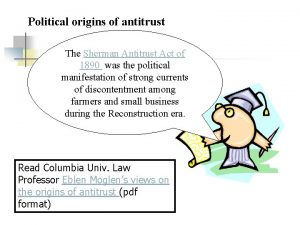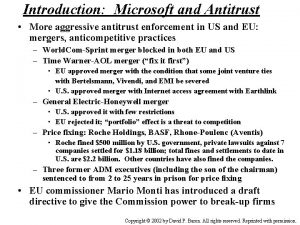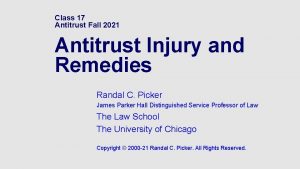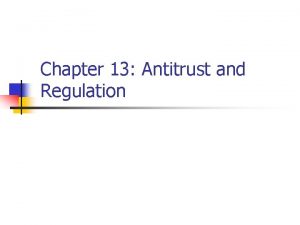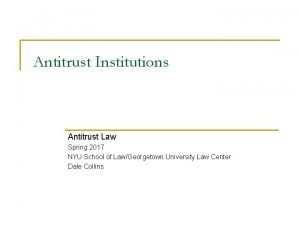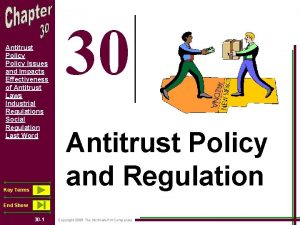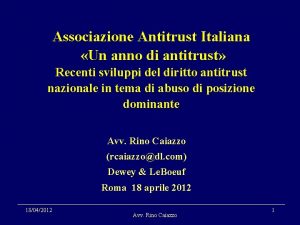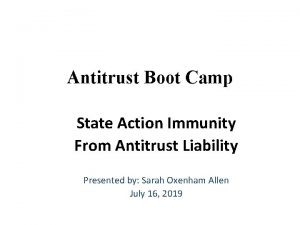ONC FAST 101 FAST Taskforce Antitrust Notice The























- Slides: 23

ONC FAST 101

FAST Taskforce Antitrust Notice • The ONC FHIR At Scale Taskforce (FAST) (Hereinafter “Taskforce”) is committed to full compliance with existing federal and state antitrust laws. • All members involved in the Taskforce effort, including its advisory groups, will comply with all applicable antitrust laws during the course of their activities. During Taskforce meetings and other associated activities, including all informal or social discussions, each member shall refrain from discussing or exchanging competitively sensitive information with any other member. Such information includes, but may not be limited to: – Price, premiums, or reimbursement charged or paid for products or services – Allocation of customers, enrollees, sales territories, sales of any products or contracts with providers – Any other competitively sensitive information that is proprietary to a member company • If you have any specific questions or concerns, seek guidance from your own legal counsel. • Members should not bring confidential information or intellectual property (hereinafter “Intellectual Property”) owned by their respective member companies into Taskforce meetings. To the extent such Intellectual Property is shared with the Taskforce that shall not be construed as a waiver of member company’s rights to, or ownership in, the Intellectual Property. 2 SK

Agenda • What is FHIR? – FHIR Adoption – Industry Levers for FHIR Adoption – Industry Efforts Towards FHIR Adoption • What is FAST? – Technical and Regulatory Barriers – Current FAST Artifacts • Collaboration and Getting Involved – FAST Process & Collaboration – Technical Learning Community 3 SK

WHAT IS FHIR? FHIR® — Fast Healthcare Interoperability Resources • An HL 7 next generation standard • Helps two computer systems talk to each other FHIR "resources" are standardized & reusable Provider Healthcare Directory Payers • Patient, practitioner, organization, device request FHIR supports common exchange methods • REST*, messaging, documents and services Patient Medical Record CDS FHIR supports the spectrum of integration • Mobile phone apps, EHR-based data sharing, institutional solutions FHIR helps with existing use cases & provides for future innovation 4 Services (eg, DME, Imaging) Public Health Research Referral/ Consult Data available in-workflow supports value-based care and population health management *Representational State Transfer (REST) defines a set of constraints used for creating web services PM

Groundswell of FHIR Activity HL 7 Da Vinci ballots Data Exchange for Quality Measures & Coverage Requirements Discovery CMS issues proposed rule requiring the use of FHIR enabled APIs (without naming a version) Clinical Notes, Backend Services and Flat FHIR, Questionnaire and Questionnaire Response completed in 2018 Jan 2018 Oct 2018 Sept 2018 Apple announces launch of Personal Health Record app using FHIR 5 Argonaut to Test SMART web messaging with CDS hooks radiology use case HL 7 Connectathon HL 7 Da Vinci Connectathon with record attendance Jan 2019 32% of certified health IT developers certified are using FHIR Release 2 87% of hospitals, 57% of clinicians using EHRs certified and enabled to use FHIR Release 2 Jul 2019 May 2019 Dec 2018 HL 7 FHIR Official Release of V 4 CARIN Alliance pilots consumerfacing FHIR AP Sep 2019 Aug 2019 HL 7 Da Vinci ballots Health Record Exchange, Payer Data Exchange, PDex Formulary, Clinical Data Exchange HL 7 Da Vinci ballots Data Exchange for Documentation Templates and Rules PM

Why FHIR Adoption? Industry value levers for FHIR adoption: Comprehensive data integration Drive innovation through data accessibility Promote progressive FHIR adoption Unlock new capabilities through API/ service methodologies Reduce redundancy and duplication Improve in-workflow data exchange to support value-based care and population health CMS and ONC rules call for widespread APIs adoption using FHIR to enable consumers access to their health data 6 Improve consistency as an impetus for accelerating clinical data exchange Reduce costs and time needed for infrastructure so it can be spent on patient care

Tying to Reality and Making Practical via CMS & ONC Proposed Rules Mandating FHIR and consumer mediation as foundations of an integrated, competitive, and innovation friendly ecosystem. CMS Proposed Rule (CMS-9115 -P) Member Empowered • Patient access through standards based FHIR APIs • Information exchange and care coordination across payers Standards Based • API based provider directories • Care coordination through trusted exchange networks ONC Proposed Rule (RIN 0955 -AA 01) • Implements information blocking provision of Cures Act (and 7 exceptions) • Standards based APIs Open APIs Care Coordination Across Payers and Providers • Certification criteria • Content specifications Innovation CMS/ONC proposes rules that align with market forces and reflect industry trends. / They provide yet another dimension to the interoperability inflection point we are in. PM

What is FAST? The FHIR at Scale Taskforce (FAST), convened by the Office of the National Coordinator for Health IT (ONC), brings together a highly representative group of motivated healthcare industry stakeholders and health information technology experts. The group is set to identify HL 7® Fast Healthcare Interoperability Resources (FHIR®) scalability gaps and possible solutions, analysis that will address current barriers and will accelerate FHIR adoption at scale. 8 PO

Standards Efforts Towards FHIR Adoption FHIR Solutions for VBC Payers/Providers Core Data Services FUNCTIONAL USE CASES SHARED RAPID INDUSTRY ADOPTION Technical Challenges to FHIR Scalability Patient & Provider Identity Management Directory Services Version Identification Scale Provider/Provider FHIR Consumer Solutions Consumers Other Collaborative Efforts to Develop & Implement FHIR Solutions 9 Exchange Process/Metadata Common Scalability Approaches Testing, Conformance & Certification Security INFRASTRUCTURE USE CASES PO

Lack of Consistent Infrastructure Impacts Flow 10 PM

Well-Planned Infrastructure Creates Efficiency 11 PM

Example FHIR Transaction Journey PCP needs information from Payer Patient visits Primary Care Physician (PCP) Payer receives PCP request REQUESTING SYSTEM Formulates FHIR Request 3 1 2 Looks Up the FHIR Endpoint for Recipient Transaction Information (eg, Header) Appropriately Configured DIRECTORY 7 PCP views patient information RECEIVING SYSTEM Requesting System Receives Data 4 5 a 5 b Receives Performs Patient Authenticates Filters Out Transaction, Matching and Sends FHIR User’s Data That Validates Role Back Not Found If Does Not Have Requestor, Unable To Do So Consent Validates Version EXCHANGE 6 Generates & Returns FHIR Response IDENTITY VERSIONING DIRECTORY EXCHANGE VERSIONING CONFORMANCE & CERTIFICATION SECURITY PILOTS 12 PM

Known Technical Barriers 2 2 1 4 2 5 3 2 3 6 1 4 13 2 3 Directory Services Identity Security 6 5 Testing, Conformance, & Certification Versioning Scaling PO

FHIR Adoption Technical Challenges DIRECTORY • How does physician know which payer? • How does payer know which physician? • How do we address the exponential growth in the number of endpoints? • How do we find an endpoint across organization boundaries? • How do we address potential endpoint variation across partners? • How do we protect endpoints from malicious attacks? SECURITY • How do we know the service consumer has permission to ask or see? • What does a scalable authentication and authorization models for FHIR based information exchange look like? • Will a scalable solution to support millions of patients/payers/ providers • How do we leverage existing security guidelines and best practices? • How do we know the FHIR consumer has permission to ask or see? IDENTITY • How do we know who the patient is? The payer? The physician? • How do we know the minimum patient data to return? • Can we rely on the consistency of identity-matching services across organizations? • How do we map patient identity realtime? • How do we address the misidentification risk? • When is member/patient ID a requirement in a FHIR resource? PO

FHIR Adoption Technical Challenges TESTING, CONFORMANCE & CERTIFICATION • How do we test and version across multiple stakeholders with varying degrees of maturity? • How do we adequately test/validate consistently in a scalable environment ? Automated tool? • How do we define the minimum level of transaction conformance and validation required? • What steps and stakeholders should be included for governance of FHIR certification? VERSIONING • How do we ameliorate the challenges adoption of different versions causes? • How do we support specific functionality when vendor's adoption variances mean they support different functions at different times? • How can we address different FHIR versions being used for the same patient? SCALING • How do we make response times more predictable and consistent to better support real-time exchanges? • How can standards be successfully implemented to support hybrid exchange models? • How do we anticipate the volume of FHIR-based transactions? • Can Implementation Guides across multiple FHIR versions be harmonized? • How do we remove definition variances between FHIR and standard RESTful APIs cause confusion? PO

Potential Regulatory Barriers HIPAA Minimum Necessary Regulatory Mandate for a Single Named Standard HIPAA Transactions Requiring X 12 Use of NPPES as the Repository for Endpoints Patient Identifier Data Blocking 16 PO

P 2 FHIR to FAST Oct 2017 – Payer + Provider (P 2) FHIR Taskforce Established Originally focused on Payer/Provider collaboration Q 1 2018 – Taskforce Charter Created Problem: Ecosystem and infrastructure barriers prevent wide-scale adoption and deployment of FHIR Purpose: Address ecosystem barriers and accelerate adoption of FHIR for production exchange of clinical information between payers and providers Need: Establish a national architecture for standardized exchange of information using FHIR Scope: Establish ONC taskforce that leverages “tiger teams” to focus on near term, practical approaches for the standardized exchange of information using FHIR Ecosystem Executive P 2 Becomes FAST Tiger Team Steering Jan 2019 Identified & Committee Same mission, new Q 2/Q 3 2018 Prioritized 21+ Formed & 1 st name to better reflect work FAST is doing Use Cases Meeting Initial Tiger Team Calls Commenced Q 2/Q 3 2018 17 Q 4 2018 and broader stakeholder engagement Technical & 14 Ecosystem Possible 1 st FAST 101 Recommendations 1 st TLC Companion Regulatory Use Cases v 1 Solutions to Webinar “Scalability” for Regulatory Virtual Barriers v 1 Published Tech Barriers Sept 12 th Guides & Pilots Barriers Webinar Q 2 2019 Q 3 2019 Published TBD Ongoing 10 am. ET End of Sept Q 2 2019 SK

FAST Organization & Community Engagement EXECUTIVE STEERING COMMITTEE FEEDBACK (public-private mix) COORDINATING COMMITTEE (public-private mix) UPDATES SEVEN TIGER TEAMS Ecosystem Use Cases Identity TECHNICAL LEARNING COMMUNITY (TLC) Security Directory, Versioning and Scale Exchange TIGER TEAMS IDENTIFY: Certification and Testing • • Pilots 18 Use Cases Technical/Regulatory Barriers Core Capabilities Gap Analysis Information Sharing with TLC through: • Website • Periodic webinars • Newsletters • TLC Meetings • Linked. In Group

FAST Initiative Output & Products Update FAST COMMUNICATION STRATEGY FAST CONTENT FAST Initiative Use Cases, Version 1 FAST Regulatory and Policy Barriers, Version 1 FAST Initiative Core Capabilities 19 FAST Solutions (In Development/ Drafts) FAST Technical Barriers, Version 1 Public Webinar Announcement FAST 101 and Keystone Presentations Technical Learning Community Planning All content is available on the FAST Project Page or https: //tinyurl. com/ONC-FAST SK

Published Content and FAST Artifacts 20 SK

FAST Focus Patient & Provider Identity Management Directory Services Version Identification Scale Exchange Process/Metadata Testing, Conformance & Certification Security Pilots 21 WANT TO GET INVOLVED? ? Join the Technical Learning Community to get updates and provide input on the technical and regulatory barriers, use cases, and proposed solutions as they are developed. SIGN UP!! & JOIN THE LINKEDIN GROUP SK

Questions?

Thank You For more information on the FAST Initiative, visit the FAST Project Page Have any further questions/suggestions? Please contact Stephen Konya at Stephen. Konya@hhs. gov & Diana Ciricean at Diana. Ciricean@hhs. gov 23
 Born with a mic flocabulary
Born with a mic flocabulary Onc fast
Onc fast Antitrust laws
Antitrust laws Clayton antitrust act
Clayton antitrust act Antitrust laws
Antitrust laws Bond geometry chart
Bond geometry chart Noc- lewis structure
Noc- lewis structure Unc hematology oncology
Unc hematology oncology Rad onc job market
Rad onc job market Onc ampliatum
Onc ampliatum Nerviano medical sciences
Nerviano medical sciences Non acid fast bacteria
Non acid fast bacteria Acid fast vs non acid fast
Acid fast vs non acid fast Slidetodoc
Slidetodoc V. c c
V. c c Từ ngữ thể hiện lòng nhân hậu
Từ ngữ thể hiện lòng nhân hậu Tư thế ngồi viết
Tư thế ngồi viết Làm thế nào để 102-1=99
Làm thế nào để 102-1=99 Hát lên người ơi
Hát lên người ơi đại từ thay thế
đại từ thay thế Khi nào hổ mẹ dạy hổ con săn mồi
Khi nào hổ mẹ dạy hổ con săn mồi Vẽ hình chiếu vuông góc của vật thể sau
Vẽ hình chiếu vuông góc của vật thể sau Công thức tiính động năng
Công thức tiính động năng Tỉ lệ cơ thể trẻ em
Tỉ lệ cơ thể trẻ em




